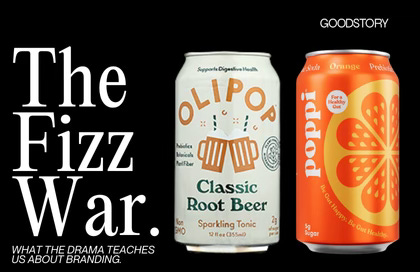What the Poppi vs. Olipop Super Bowl Drama Teaches Us About Brand Marketing
Fizz Fight: How a Flashy Influencer Campaign Exposed the Bubbling Tension Between Two Prebiotic Soda Rivals
Hello friends,
The battle of the prebiotic sodas just hit a boiling point.
Poppi and Olipop—two leading brands in the functional soda space—have been duking it out for market share, cultural relevance, and brand loyalty. But this past Super Bowl weekend, the rivalry escalated from quiet competition to full-on controversy.
Poppi’s bold marketing stunt—sending influencers personal branded vending machines—backfired when social media users called it wasteful and out of touch. Olipop, never one to miss an opportunity, fanned the flames by commenting on viral videos and (falsely) claiming the vending machines cost $25,000 each.
The result? A PR firestorm. Accusations. Damage control. A viral moment that brands dream of and dread at the same time.
But beneath the social media spectacle, there’s a lesson in marketing strategy, competitive positioning, and the fine line between bold and tone-deaf branding. Let’s break it down.
1. Brand Perception is Built in the Details
Poppi’s vending machine stunt was obviously more than a gift. It was a brand statement. The company has always leaned into influencer marketing, and this was an extension of that playbook. But this time, the execution clashed with consumer sentiment.
To some, the vending machines felt extravagant, performative, and misaligned with the brand’s everyday consumer image. The backlash wasn’t about influencers getting free stuff (that happens all the time). It was about who was getting the freebies and what that said about the brand’s priorities.
Olipop seized the moment, reinforcing its own brand identity as the more “accessible” alternative. By jumping into the comments and positioning Poppi as reckless with its spending, Olipop crafted a subtle but effective contrast:
Poppi throws money at influencers.
Olipop is the people’s soda.
Even though their vending machine claim was later debunked, the narrative stuck. That’s the power of perception.
2. Competitor Commentary is a High-Stakes Move
Olipop’s decision to publicly engage in the controversy was risky—but strategic. Instead of sitting back and letting Poppi take all the attention, Olipop inserted itself into the conversation, making sure consumers saw them as the alternative.
This kind of competitive marketing can be a double-edged sword. If done well, it sharpens your positioning and builds loyalty. If done poorly, it can look desperate or petty.
Olipop’s move worked because:
It played into the existing narrative. They didn’t start the backlash, they amplified it.
It leaned into their challenger brand status. Unlike Coca-Cola vs. Pepsi, this isn’t a fight between giants. It’s a battle of two startups trying to win over the same niche audience.
It kept things snappy. A few well-placed TikTok comments? Just enough to stir the pot without looking like a full-on attack.
Of course, the misinformation backlash took some wind out of Olipop’s sails. But by then, the damage to Poppi’s campaign had already been done.
3. Owning the Narrative is More Important Than Ever
Poppi’s response? Damage control with a side of deflection.
Founder Allison Ellsworth quickly addressed the controversy, calling out Olipop for spreading false information and reaffirming Poppi’s commitment to its community. The message: We hear you. We’ll do better. But let’s not forget who started this drama.
This kind of direct founder-led response is becoming more common in the era of social media-driven brand crises. Consumers want accountability, but they also want authenticity. The best crisis responses:
Acknowledge the backlash. Ignoring it only fuels speculation.
Correct misinformation. Olipop’s price claim wasn’t true, and Poppi made sure to say so.
Reinforce brand values. Ellsworth reminded audiences that influencer marketing built Poppi from the ground up—and they weren’t about to abandon it.
Did Poppi’s response completely erase the controversy? No. But it shifted the conversation from outrage to a learning moment, which is often the best-case scenario in brand PR.
The Bigger Lesson: Marketing Moves Fast, But Consumers Move Faster
Poppi’s vending machine stunt wasn’t a total flop—after all, we’re still talking about it. But it highlights a growing tension in brand marketing: big, attention-grabbing stunts can backfire when they feel disconnected from consumer priorities.
Olipop’s real win wasn’t in the TikTok comments. It was in positioning itself as the more relatable, community-driven brand without even running a Super Bowl ad (that’s a couple million dollars saved).
The takeaways?
Know your audience. What works for influencers doesn’t always work for the masses.
Stay agile. Social media backlash moves fast; brand responses need to move faster.
Play offense and defense. Olipop took a risk and won short-term attention, but long-term brand equity is built on trust—not viral moments.
In the end, both brands got what they wanted: Poppi dominated the conversation, and Olipop strengthened its positioning. But for marketers watching from the sidelines, this was a reminder that in the battle for brand relevance, every move matters.





